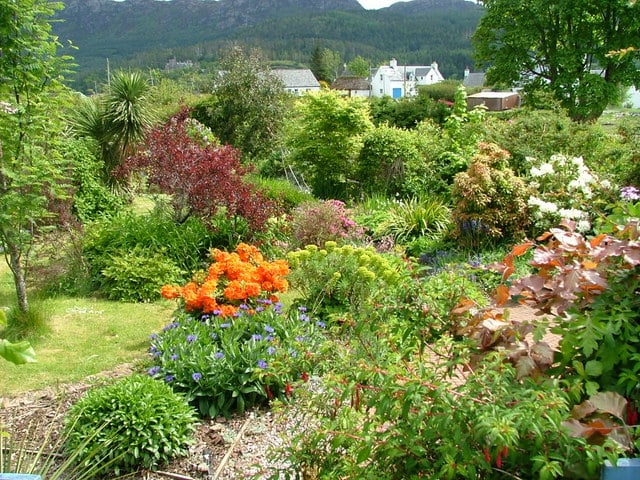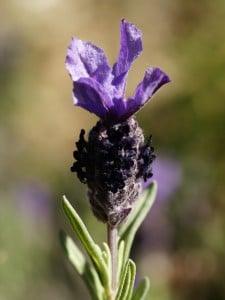Making, using, loving garden compost
What is garden compost?
In this post we’re talking about the compost made in a heap or bin out of garden and kitchen waste. We’re not talking about the commercially produced potting or seed compost for your seeds, seedlings and houseplants which comes in sacks from nurseries and garden centres.
Phew! Glad we got that straight at the beginning.
What’s the point of making garden compost?
In our desire to have beautiful plants and gardens it’s tempting simply to ignore soil. But to get the most out of our gardens, soil does have to be looked after. It has to be kept, as gardeners sometimes say, ‘in good heart’.
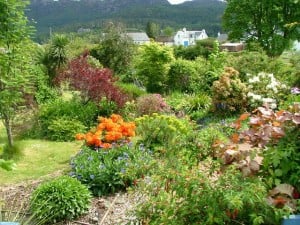
One of many beautiful gardens in Plockton, Ross and Cromarty. © Copyright Dave Fergusson and licensed for re-use under Creative Commons Attribution-ShareAlike 2.0 Generic (CC BY-SA 2.0)
Introducing bulky organic* matter, such as garden compost or well-rotted manure, into the soil is the best way of caring for it. (*Organic here just means ‘derived from living matter’.)
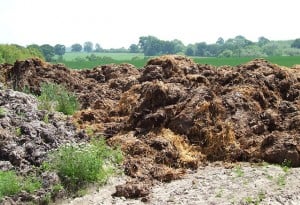
Muck at edge of a field near Much Wenlock, Shropshire. © Copyright Roger Kidd and licensed for re-use under Creative Commons Attribution-ShareAlike 2.0 Generic (CC BY-SA 2.0)
Good soil is full of helpful micro-organisms and worms. They warm the soil as they work and can transform garden compost into slow-release plant nutrients and humus.
Garden compost can help break up sticky clay soil and turn fine sandy soil into more useful crumb-sized particles. A good crumby soil structure (think of a good loaf of bread or a scone) will ensure that air and water get to your plants, and also conserve moisture. Crumby soils can hold on to nutrients better and plant roots can access nutrients more easily.
Making and using your own garden compost is a straightforward way towards beautiful plants and gardens. It's a fairly simple process. The gist is that you pile up a mixture of mostly plant material (kitchen and garden waste) and it breaks down into a usable substance.
What do I need?
A good balance of ingredients, a mixture of garden and kitchen waste:
* mostly brown carbon-rich material: coarse but not woody twigs, prunings cut small, scrunched up newspaper, torn up cardboard, dry leaves, corn cobs
* mostly green nitrogen-rich material: green plant material, grass cuttings (go easy with these – see below), weeds, vegetable peelings, coffee grounds, tea leaves, seaweed
* water (friendly bacteria and other micro-organisms can’t work unless there’s enough moisture)
* air (essential for aerobic composting – which means, in part, without nasty smells).
And to jumpstart the process and to keep it moving, you’ll need:
* some soil or ready made compost or soil full of those friendly micro-organisms
* an ‘accelerator’ that gets things going and keeps them moving (something with nitrates in it – a commercial high nitrate fertilizer like ammonium sulphate, nettles, comfrey leaves, or even urine as used by the National Trust).
NEVER put bread, meat, dairy products, fat, seeding weeds or perennial roots in the compost.
How do I do it?
Composting is an art and a science - and it's simple! Here’s an outline of how to go about it.
Find a place for your compost container, which could be a ‘Dalek’ style plastic bin, a wooden purpose built square, a compost tumbler or a DIY square made of wooden pallets or a mix of wood and wire netting. You need to be able to put things in it and take compost out of it easily.
Put a layer of twigs at the bottom to encourage air circulation.
Arrange your green and brown materials in layers. Don’t let one material dominate the heap. And if you’re using grass cuttings, layer them with cardboard or scrunched up newspaper. Shred larger items so they decompose more easily.
Every so often, add some accelerator.
If the ingredients are very dry, spray them with water to make the pile about as damp as a damp sponge. Don’t soak it.
Top off with soil or already made garden compost.
A full heap or bin will start to heat up as the decomposition process gets underway. After a few weeks, when it begins to cool down slightly, turn it with a fork to introduce more oxygen and to move non-decomposed material into the middle. Add water if it's drying out. This will get the heating process going again. In warm conditions, and if you turn it regularly, your compost will be ready in about 2-4 months. When your mixing no longer leads to a hotter compost and the compost has an earthy texture and smell, the process is complete.
If you want a fast turnaround, heat the compost by adding a good amount of accelerator and moisture, and turn the heap every few days.
Or let nature take its course: a heap left unattended and filled with bulkier, unshredded material may take over a year to fully decompose.
Problems?
Too many grass cuttings or leaves can turn into a slimy and smelly mess because there’s not enough air in the mix. Break it up with brown material such as straw, shredded hedge clippings or crumpled newspaper. Make sure you turn your heap periodically to get more air in.
Too many grass cuttings for your compost bin to handle? Use them as mulch for your raspberries, which will love the nitrogen and potassium. Or, from time to time, leave them to break down on the lawn.
If you’ve got too many tree or shrub leaves it’s probably best to make leaf mould separately as leaves decay very slowly. Either create and fill a leaf cage, using wire netting and squashing leaves down hard as you go (jumping on them is good!) or push them hard into plastic sacks and pile those up out of sight. After a couple of years open them up – leaf mould! Ideal to mix with garden soil or use as a mulch.
Lots of little flies? Fruit flies love your fruit and vegetable waste and the compost is probably too wet. Add some shredded newspaper.
If you don't have enough room, what about a wormery?
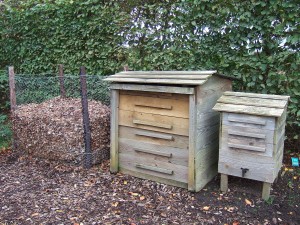
The perfect trio? Leaf cage, compost heap and wormery at the Royal Horticultural Society garden at Wisley. © Rowan Adams and licensed for re-use under Creative Commons Attribution-Share Alike 4.0 International licence.
Sign up for our emails below, so we can send you blogs on gardening tips, as well as updates on our sales, so you don’t miss out on those garden furniture bargains!


